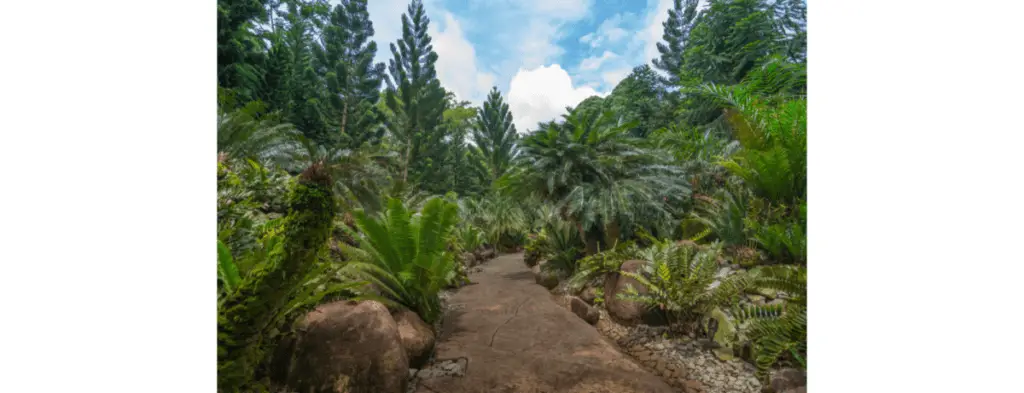
Often touted as a Botanic Garden, a Botanical Garden may be described as a home or designated area for multiple plants. They are primarily created to understand the diverse relationships that persist within the various groups of plants. Currently, you will find almost all botanical gardens preserving and flaunting an excellent range of ornamental but thriving plants.
The key behind putting these plants out for display is to highlight the many organic relationships that exist within multiple plant groups. A botanical garden is also driven by two key elements- the overall appeal and the order of taxonomy. At some point, plants that carried medicinal value and were imperative for the proper functioning of botanic gardens are now displayed for the sheer cause of historical appeal.
Having said that, what is an arboretum and what are its similarities and differences when compared to botanic gardens? We will find that and a lot more in the following few sections.
Arboretum vs botanical garden
If you are a gardening enthusiast, you have probably heard of arboretums. But how exactly do they compare with botanic gardens and what are their primary similarities and differences? To put it simply, an arboretum is a garden that is primarily driven to protect and develop woody plants. These can range from moderately sized shrubs to lofty trees.
As you can probably guess arboretums are areas that are specifically dedicated to planting a range of woody shrubs and small trees. They are completely different from how a forest or park would look or operate. So, to put it in the simplest terms it is an extensive and sprawling outdoor museum carrying an excellent range of trees. Several individuals plant and grow trees in arboretums to ensure consistent research, address ornamental needs, and educate thriving botanists.
At this point, you have probably noticed several similarities between an arboretum and a botanic garden. But there are some interesting differences as well. Unlike arboretums that anyone can set up on an open piece of land, a Botanical Garden often stands out as a historical icon of the specific location. It has a set of excellent plants that are scientifically managed to educate and conduct extensive research. You will also find multiple laboratories and libraries that are specific to the many plant undertakings.

Which botanical garden has the world’s largest collection of plants | Royal Botanic
Now that you know all about arboretums and Botanic gardens you are probably wondering which specific garden boasts the highest collection of plants. The top garden to feature in this list is the Royal Botanic Garden which is best known for its iconic plant collection. Located in Kew, this garden boasts plants across several thousand species up to 17,000. It has also been known for establishing a new record for boasting the maximum number of living species at a single location. Such is the popularity of the Royal gardens that it was also captured by the Guinness World Records.
The Royal Garden comes with an extensive history as well. It was established way back in 1759 and as of May 2019, the plant species touched the threshold of 17,000. This way it is a single botanic area with the highest collection of thriving flora. According to the horticulture director presiding at RBG, this is one of the best accolades. Mr. Barley is extremely thrilled to have recorded the highest living number of plants across the globe. He also strongly believes that keeping a thriving botanic garden such as theirs improves the importance of these gardens across the globe. These are not just exceptional places to check out but also one the primary operational and educational hubs.
Over the coming years, the plants will only grow in number and a vast number of additional plants will be incorporated into the garden collections. Kew Gardens, for instance, expects to welcome many new species and subspecies of plants in the coming years.
Also recognized as one of the crucial UNESCO Heritage sites, this garden is known to hold an excellent range of plants like the Titan Arum which is often known as one of the most foul-smelling plants across the globe. The smell is so distinct that it would compel you to remove it from your current location. Interestingly enough, Arum is also one of the tallest plants across the globe. So, it has two unique feathers on its cap.
Two years back in 2020, a specific specimen at a Kew nursey was awarded an honorary position for the longest plant trap based on the Nepenthes. It has overall specs of 43 cm starting from the base of the nursery and going right up to the lid.
RBG Kew also hosts the biggest seed repository across the globe. Also known as the Millennium Seed Bank, you will find this at the Sussex Wakehurst location. You will find more than 2.4 billion seeds in this bank, and it comes from close to 40,000 different species. As per the insights from Millward, GWR’s managing editor, he had the iconic chance to smell the unique odor of the Arum and he would call that a life-changing moment. Overall, everyone at Kew is excited to thrive and maintain their exclusive collection of plants.
Now that you know all about the most iconic botanical gardens across the globe, you probably know where to head for your upcoming wilderness retreats. Because we also shared some insights regarding the differences between botanic gardens and arboretums you know how to differentiate between the two. This way, it will also be easier to identify botanic gardens from arboretums and vice versa.
What is the purpose of a botanical gardens| Plant search gardens
The purpose of a botanical garden is to research plants, tree conservation, conservation horticulture and collaborates with other public gardens. They also do plant search for integrated plant into climate.
This post contains affiliate links. If you make a purchase through these links, we may receive compensation at no additional cost to you.

